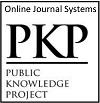REVIEW OF INFORMATION TECHNOLOGY UPDATE ON QUALITY CONTROL AND QUALITY ASSURANCE OF HALAL PRODUCTS
Abstract
Keywords
Full Text:
PDFReferences
W. Montagna and J. S. Yun, “The Skin Of The Domestic Pig,†J. Invest. Dermatol., vol. 170, no. 1, pp. 11–22, 1963.
D. C. Carrer, C. Vermehren, and L. A. Bagatolli, “Pig Skin Structure And Transdermal Delivery Of Liposomes : A Two Photon Microscopy Study,†J. Control. Release, vol. 132, no. 1, pp. 12–20, 2008.
K. A. Abeng, S. J. R. Kalangi, and S. Wangko, “Gambaran Struktur Kulit Hewan Coba Pada Beberapa Interval Waktu Postmortem,†J. e-Biomedik, vol. 4, no. 1, pp. 7–10, 2016.
M. E. S. Mirghani, H. M. Salleh, Y. B. C. Man, and I. Jaswir, “Rapid Authentication of Leather and Leather Products,†Adv. Nat. Appl. Sci., vol. 6, no. 5, pp. 651–659, 2012.
A. Guntarti, A. Rohman, S. Martono, and A. Yuswanto, “Autentikasi Lemak Celeng Dengan Kromatografi Gas- Spektroskopi Massa Yang Dikombinasikan Kemometrika PCA ( Principle Component Analysis ),†in Rakernas dan Pertemuan Ilmiah Tahunan Ikatan Apoteker Indonesia, 2016, pp. 57–63.
O. Dahimi, M. S. Hassan, A. A. Rahim, S. M. Abdulkarim, and S. M. A, “Differentiation of Lard from Other Edible Fats by Gas Chromatography- Flame Ionisation Detector ( GC-FID ) and Chemometrics,†J. Food Pharm. Sci., vol. 2, pp. 27–31, 2014.
A. Rohman, K. Triyana, Sismindari, and Y. Erwanto, “Differentiation Of Lard And Other Animal Fats Based On Triacylglycerols Composition And Principal Component Analysis,†Int. Food Res. J., vol. 19, no. 2, pp. 475–479, 2012.
S. Hermanto, A. Muawanah, and R. Harahap, “Profil dan Karakteristik Lemak Hewani (Ayam, Sapi dan Babi) Hasil Analisa FTIR dan GCMS,†Valensi, vol. 1, no. 3, pp. 102–109, 2008.
M. Povalo and G. Contarini, “Analysis of Triglycerides in Butter and Lard Using An MET-Biodiesel GC Column,†Eur. J. Lipid Sci. Technol., vol. 110, no. 11, pp. 1050–1057, 2008.
E. Kurniawati, A. Rohman, and K. Triyana, “Analysis Of Lard In Meatball Broth Using Fourier Transform Infrared Spectroscopy And Chemometrics,†MESC, vol. 96, no. 1, pp. 94–98, 2014.
DOI: http://dx.doi.org/10.22373/cs.v2i1.2481
Refbacks
- There are currently no refbacks.
Copyright (c) 2018 Muhammad Ridwan Harahap
except where otherwise noted.























